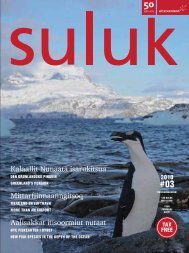Klik her for at se PDF'en - Air Greenland
Klik her for at se PDF'en - Air Greenland
Klik her for at se PDF'en - Air Greenland
You also want an ePaper? Increase the reach of your titles
YUMPU automatically turns print PDFs into web optimized ePapers that Google loves.
The time when the snow cover melts<br />
away combined with the temper<strong>at</strong>ures<br />
is crucial <strong>for</strong> the start of plant growth<br />
and <strong>for</strong> the time when the plants<br />
bloom. Since the snow doesn’t melt<br />
until June, when the sun is highest in<br />
the sky, it has gre<strong>at</strong> bearing how early<br />
the plants start growing. The earlier<br />
they start growing and blooming, the<br />
more they benefit from the full energy<br />
of the sun. In years with a l<strong>at</strong>e snow<br />
melt, t<strong>her</strong>e are many plants th<strong>at</strong> do not<br />
produce m<strong>at</strong>ure <strong>se</strong>eds.<br />
Similarly, the emergence of flying<br />
in<strong>se</strong>cts in spring and life in lakes and<br />
ponds is completely dependent on the<br />
time when the snow and ice melts.<br />
The egg-laying of wading birds can be<br />
delayed <strong>for</strong> up to 2-3 weeks in years<br />
with particularly widespread snow<br />
cover. In such years, the young are<br />
h<strong>at</strong>ched correspondingly l<strong>at</strong>er and t<strong>her</strong>e<strong>for</strong>e<br />
have less time to grow big and<br />
strong be<strong>for</strong>e, <strong>at</strong> the age of just 6 - 10<br />
weeks, they must undertake the long<br />
migr<strong>at</strong>ion across the North Atlantic to<br />
their winter quarters in Europe and<br />
Africa.<br />
Snow and the musk-oxen<br />
The time of the snow melt has also<br />
gre<strong>at</strong> significance <strong>for</strong> the musk-oxen’s<br />
exploit<strong>at</strong>ion of the countryside, al -<br />
though periods with thaw in winter<br />
are a <strong>se</strong>rious thre<strong>at</strong> to the popul<strong>at</strong>ion.<br />
In the period during which we<br />
have knowledge of the conditions in<br />
<strong>Air</strong> <strong>Greenland</strong> inflight magazine 57<br />
Northeast <strong>Greenland</strong>, the musk-oxen<br />
have almost been eradic<strong>at</strong>ed <strong>se</strong>veral<br />
times in large parts of the country<br />
when glaze ice has covered the countryside<br />
and the veget<strong>at</strong>ion. This has<br />
prevented the musk-oxen from obtaining<br />
food and they have starved to<br />
de<strong>at</strong>h.<br />
The amount of winter precipit<strong>at</strong>ion<br />
and t<strong>her</strong>eby the thickness of the snow<br />
cover will increa<strong>se</strong> significantly in the<br />
future, but this factor will, to a certain<br />
extent, be counteracted by the hig<strong>her</strong><br />
spring temper<strong>at</strong>ures which will cau<strong>se</strong><br />
a faster snow melt. It is very likely th<strong>at</strong><br />
t<strong>her</strong>e will be gre<strong>at</strong>er fluctu<strong>at</strong>ions from<br />
year to year in the amount of snow<br />
cover and <strong>at</strong> the same time t<strong>her</strong>e will<br />
be a gre<strong>at</strong>er vari<strong>at</strong>ion between years<br />
with an early snowmelt and years with<br />
an extremely l<strong>at</strong>e snowmelt. In years<br />
with large amounts of snow and a<br />
cold spring t<strong>her</strong>e could be an almost<br />
total lack of reproduction on the part<br />
of many plants and animals. All this<br />
means th<strong>at</strong> Northeast <strong>Greenland</strong>’s<br />
n<strong>at</strong>ure is facing big changes, but it also<br />
means th<strong>at</strong> conditions could origin<strong>at</strong>e<br />
<strong>her</strong>e, th<strong>at</strong> could have dram<strong>at</strong>ic con<strong>se</strong>quences<br />
<strong>for</strong> the ocean currents and<br />
t<strong>her</strong>eby the global clim<strong>at</strong>e.<br />
■ T<strong>at</strong>sini ta<strong>se</strong>qqanilu uumasoqassutsimut<br />
qaqugukkut aputip aannera sunniutilerujussuusarpoq.<br />
M<strong>at</strong>umani qeriuaannartup masarsoqarfiani<br />
ta<strong>se</strong>qqami qaleruallit assigiinngitsut<br />
akornanni sunniivigeq<strong>at</strong>igiinneq misissorneqarpoq.<br />
■ Livet i søer og damme påvirkes stærkt af,<br />
hvornår i<strong>se</strong>n smelter. Her undersøges samspillet<br />
mellem de <strong>for</strong>skellige krebsdyr i en dam på<br />
tundraen.<br />
■ The time when the ice melts has a strong<br />
effect on life in the lakes and ponds. Here, the<br />
interaction between the various crustaceans in<br />
a pond on the tundra is studied.<br />
Zackenberg<br />
The re<strong>se</strong>arch st<strong>at</strong>ion <strong>at</strong><br />
Zackenberg is centrally situ<strong>at</strong>ed<br />
in the N<strong>at</strong>ional Park in Northeast<br />
<strong>Greenland</strong> and it is <strong>her</strong>e th<strong>at</strong> one<br />
of the most comprehensive and<br />
cohesive re<strong>se</strong>arch programmes<br />
in the Arctic is being carried<br />
out under the leadership of the<br />
Danish Polar Centre, Copenhagen<br />
University, the N<strong>at</strong>ional Environmental<br />
Re<strong>se</strong>arch Institute <strong>at</strong><br />
Århus University and the <strong>Greenland</strong>ic<br />
<strong>se</strong>ctor re<strong>se</strong>arch institutes<br />
Asiaq and the <strong>Greenland</strong> N<strong>at</strong>ure<br />
Institute. Zackenberg, which is<br />
owned by the <strong>Greenland</strong> Home<br />
Rule Government and run by<br />
Danish Polar Centre, is a modern<br />
re<strong>se</strong>arch st<strong>at</strong>ion with a total of 10<br />
big and small hou<strong>se</strong>s and its own<br />
runway. The st<strong>at</strong>ion is normally<br />
open from the end of May until<br />
around September 1st.<br />
Since 1995, <strong>se</strong>veral hundred<br />
Danish and <strong>for</strong>eign re<strong>se</strong>arc<strong>her</strong>s<br />
and scientists have documented<br />
every ob<strong>se</strong>rvable corner of the<br />
high Arctic n<strong>at</strong>ure <strong>at</strong> Zackenberg.<br />
Their re<strong>se</strong>arch has now been collected<br />
in its entirety in the book<br />
»High-Arctic Ecosystem Dynamics<br />
in a Changing Clim<strong>at</strong>e – Ten<br />
years of Monitoring and Re<strong>se</strong>arch<br />
<strong>at</strong> Zackenberg Re<strong>se</strong>arch St<strong>at</strong>ion,<br />
Northeast <strong>Greenland</strong>« which is<br />
published by Academic Press.



